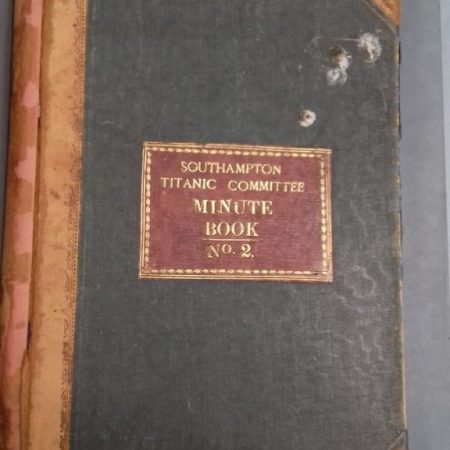Southampton Archives are located in the basement of the south block of the Civic Centre, Southampton, SO14 7LY, close to the Southampton Local History and Maritime Library. [Link to 5.4.4.2]. The Reading Room is open to the public Tuesdays and Wednesdays between 10 and 4, though documents cannot be produced from the strong-rooms 12.30-13.30. Tel: 23 8083 2251 (Tuesdays and Wednesdays), email city.archives@southampton.gov.uk.
The Archives hold extensive records relating to Southampton and its people, dating from 1199 to the present, and includes:
· Records of Southampton City Council and predecessor authorities, reflecting town administration, property ownership, finance and trade, justice and poor relief.
· Records of local Boards, commissioners and companies whose responsibilities were absorbed by the Council (for example, the Pavement Commissioners, Boards of Health and the Northam Bridge Company) .
· Southampton City Council departmental records, such as Building Control, Education and Police.
· Ecclesiastical records for Southampton parishes, including original parish registers of baptisms, marriages and burials.
· Archives of individuals, organisations, businesses, institutions etc., germane to the history of Southampton.
· Public records relating to Southampton and its interests, including records of hospitals, magistrates’ courts and maritime matters.
· Images, some of which can be found in the Local History and Maritime Digital Archive, including photographs of war-damaged properties, houses demolished during slum clearances, activity in the docks, building works and events.
One of the collection’s particular strengths is the series of borough archives dating from the 14th century onwards. A defence terrier of 1454 lists all the households in the town responsible for the upkeep of the walls. Brokerage books (which survive for 1430-1566 and are unique to Southampton) contain a series of accounts recording all goods and carriers passing through the Bargate.
Petty Custom Books (1426-1803), also known as Port Books, record all goods arriving and leaving by sea. These list all kinds of trade from precious luxury goods such as silk and spices from the east, to more mundane imports, such as herring. They also give information about the merchants and ships engaged in trade.
The sea is a major theme in the collections: nineteenth century crew lists and twentieth century merchant navy records provide information on ships and the men and women who sailed on them. These sources attract researchers from all over the world.
The Archives document stories of the various communities who came to Southampton: traders who settled here, people seeking refuge from religious persecution such as the Huguenots, and more recently immigrants settling for economic reasons, for example, the post-war African Caribbean community.
About 60% of the Archives catalogues can be searched on Discovery, on the National Archives site. Other finding aids are available in the Reading Room, including subject guides to records, indexes to people and places and specific indexes to certain records, including a cross-parish surname index to parish baptisms, marriages and burials.
Southampton is well known for its Second World War history: the Archives contain important written and photographic material reflecting the impact of war on Southampton and its people. War-damaged photographs and maps bear witness to the devastation caused by bombing raids, whilst it is possible to find record cards for individual properties with levels of damage recorded.
The Central Index Register of Merchant Seamen
This contains about a million and a quarter record cards with details of those serving between 1918 and 1941, not only British seafarers but also foreign men and women working on board British registered vessels. It records deck crew, engine crew and victualling crew. Record cards may give the name, date and place of birth, rating and discharge number of a seafarer, as well as details of any maritime certificates. Dates of engagement or discharge on board particular vessels are given, which help build up the service history of an individual. Cards for some seafarers include a physical description (even down to their tattoos!) and the CR 10 series of the register (which covers 1918-1921) even has a passport-style photograph of the seafarer. The original Register can be viewed free of charge in the Reading Room. A copy is also available on microfiche at the National Archives, Kew, or online through the family history website FindMyPast.The Oral History Archive
Southampton’s acclaimed Oral History Unit operated from 1983 to 2008 and recorded the life histories and experiences of local people. The collection, now held in Archives, has about 800 recordings and over 5000 related photographs documenting the lives of seafarers, shipyard workers, Titanic survivors, and local communities. Early projects recorded memories of the city’s African Caribbean community, women in the First World War, dock workers and dockland communities. Subsequent projects followed, many reflecting Southampton’s maritime history: for example, projects on the impact of the Titanic disaster, female seafarers and life on board the Queen Mary. Some projects concentrated on particular areas of Southampton (Chapel and Northam, Millbrook, Woolston and Holy Rood) whilst others highlighted the experiences of people settling in the city (such as Asian women and the Polish community). There were also projects on cinema in Southampton, Trades Council and football, whilst a large number of recordings bear witness to the impact of the Second World War on Southampton.
Minute Book, No 2, of the Southampton Titanic Committee
Entry of 3 June 1913 in the Minute Book, No 2, of the Southampton Titanic Committee
A small part of the stack of the Central Index Register of Merchant Seamen
Crew records from the Central Index Register of Merchant Seamen
The Inoculation Book, 1774-1783 by Mary L. South, Southampton Records Series, Vol. 47.

